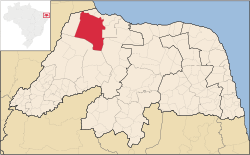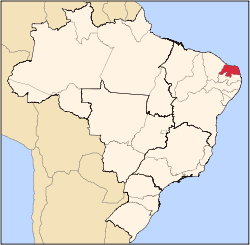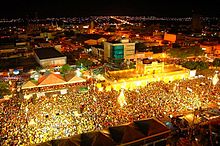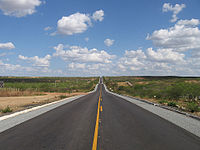- Mossoró
-
Mossoró — Municipality — The Municipality of Mossoró Mossoró's Skyline 
Flag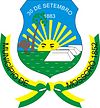
SealNickname(s): "Capital do Oeste" ("The Capital of the West") and "Cidade do Sal e do Petróleo" ("City of Salt and Petroleum")
Motto: Mossoró da gente. Fazendo nossa vida melhorar. (Our Mossoró. Improving our lives.)
Location of Mossoró in the State of Rio Grande do Norte Country  Brazil
BrazilRegion Northeast State  Rio Grande do Norte
Rio Grande do NorteFounded 1852 Government – Mayor Maria de Fátima (Fafá) Rosado Nogueira (DEM) Area – Total 2,110.207 km2 (814.755 sq mi) Elevation 20 m (66 ft) Population (2010) – Total 259,886 – Density 123.17/km2 (318.9/sq mi) [1] Time zone America/Fortaleza (UTC-3) – Summer (DST) DST Not Observed (UTC-3) Postal Code 59600 ISO 3166 code BR-RN HDI (2000) 0.735 – medium Website Prefeitura de Mossoró Footnotes:
Semi-arid climate (mesoregion Agreste-Potiguar) with a temperature range of mean lows around 22.5º Celsius (72.5°F) in winter and mean highs around 33.3º Celsius (91.94°F) in summer.
Mossoró is located at -5.1875 [latitude in decimal degrees] (5° 11′ 17″ South), -37.3442 [longitude in decimal degrees] (37° 20′ 39″ West) at an elevation/altitude of 20 meters.
Google MapMossoró is the second most populous city in the state of Rio Grande do Norte, Brazil. It is equidistant (four hours' drive) from Natal (approximately 277 km or 172 miles), the state capital of Rio Grande do Norte, and from Fortaleza (approximately 260 km or 161.5 miles), the capital of the state of Ceará. It is located nearly in the center of the Nordeste region, which has about 53.6 million people (28% of Brazil's population). It is also in the heart of Brazil's salt production area. Situated in the Agreste-Potiguar mesoregion, Mossoró is the country's largest land-based petroleum producer[2][3].
Contents
History
For Brazilians, the main historical distinctions of the city are the driving out of the "Lampião", a gang that plundered entire towns in the sertão during the 1920s and 1930s, and the freeing of slaves five years before the Lei Áurea abolished slavery in all of Brazil (1888). It was also the first city to give women the right to vote in Latin America (Professor Celina Guimarães Viana cast the first vote in 1928), sparking a movement among other cities and states in Brazil that culminated in the official recognition of women's suffrage by the national government in 1934. The city is the seat of the Roman Catholic Diocese of Mossoró.
Population Growth
1991 1996 2000 2007 2008 2009 2010 192,267 205,214 213,841 234,390 241,645 244,287 259,886* -
- The IBGE population estimate for Mossoró as of 2010 stands at 259,886 people[4] (96th largest municipality in Brazil).
Culture and Recreation
Although it does not have beaches within its city limits, there are several magnificent beaches in the surrounding area of the Costa Branca Pole such as the desert beaches of the city of Areia Branca. World-famous Canoa Quebrada beach is a short drive away in the neighboring state of Ceará.
The Resistance Museum tells the story of the city and the city's native sons. However, the most famous attraction is the Mossoró Cidade Junina (Mossoró Junina City Festival), a summer festival (festa junina) that attracts more than a million people during the month of June.
The city has a beautiful historic town, a hub of fascinating stories of the region's development. Main attractions include the Museu Municipal Jornalista Lauro da Escóssia (Journalist Lauro da Escóssia Municipal Museum), also known as the Cangaço Museum, the Station Arts old railway station museum, the Oil Museum, St. Vincent Church, and the Cathedral of Santa Luzia. Other attractions include the famous Palace of Resistance, former residence of mayor Rodolfo Fernandes who was the leader of the resistance against the "Lamp band" (Lampião) and served as a rampart against attacks from those notorious bandits. There is also the Bode Market, an ovine and caprine trading center where traders and buyers of sheep and goats continue the long-held rural traditions of the northeast, as well as the famous Central Market and the Railway Bridge.
In September, the city stages what could be the largest play in the world, the Auto Da Liberdade (The Procession of Liberty) with an all-paid cast of 2,000 and a 600-member chorus as part of its Festa da Liberdade (Brazilian independence celebrations).
Mossoró also has a shopping center, Mossoró West Shopping, which includes a 5-screen multiplex cinema, Wi-Fi internet connectivity, children's recreation and diaper changing area, ATMs, bowling alley, pharmacy, and food court among its many amenities.
Mossoró is also home to the Hotel Thermas Resort which is the largest thermal water park in Brazil. The heated water used in the resort arises from a zone of geothermal hot springs located in the vicinity of the city.
Education
Colleges and Universities
The Federal University of the Semi-Arid is located in Mossoró.
The following have campuses in the city:
- Faculdade de Ciências e Tecnologia Mater Christi
- Faculdade de Enfermagem Nova Esperança de Mossoró - FACENE/RN
- Universidade do Estado do Rio Grande do Norte
 Façade of the Secretary of Finance Building
Façade of the Secretary of Finance Building
Grade Schools and High Schools
You can see a listing of public and private elementary, junior, and senior high schools in Mossoró HERE (In Portuguese.)
Regional Transportation
Airports
Mossoró is served by the following airports:
- Mossoró Airport (Dix-Sept Rosado Airport) - 2.7 km away
- Aeroporto Internacional de Fortaleza (Pinto Martins International Airport) - 205.2 km away
- Aeroporto Internacional de Natal/Augusto Severo International Airport (Wikipedia page) - 245.8 km away (will be handed over to the Brazilian Air Force at the end of 2013)
- Aeroporto Internacional da Grande Natal or Greater Natal International Airport will open in 2014 in time for the 2014 FIFA World Cup.
Highways
- BR-304
- BR-110
- BR-405
- BR-437
Distances to Other Brazilian Cities
São Paulo Rio de Janeiro Brasília Salvador Belo Horizonte Curitiba Porto Alegre Manaus 2,274 km - 1,413 miles 2,070 km - 1,286 miles 1,652 km - 1,027 miles 876 km - 544 miles 1,779 km - 1,105 miles 2,588 km - 1,608 miles 3,126 km - 1,942 miles 2,529 km - 1,571 miles Images
See Also
- List of cities
- List of major cities in Brazil
- List of municipalities of Brazil
- Municipalities of Rio Grande do Norte (RN)
External Links
- (Portuguese) Official Website
- (Portuguese) Mossoró Cidade Junina Official Site
- (Portuguese) LFG
- (Portuguese) Federal University of the Semi-Arid
- (Portuguese) De Fato Newspaper
- (Portuguese) Thermas Resort
Coordinates: 5°11′16″S 37°20′38″W / 5.18778°S 37.34389°W
References
- ^ [1]
- ^ [2]
- ^ http://www.anp.gov.br/brasil-rounds/round4/round4/workshop/restrito/ingles/Potiguar_ing.pdf
- ^ "Brazilian Institute of Geography and Statistics". 2010. http://www.ibge.gov.br/cidadesat/topwindow.htm?1. Retrieved 2010 Census - First results. "IBGE - Cities@"
 Brazil
BrazilHistory First inhabitants · Colonization · Empire · Old Republic · Vargas Era · Second Republic · Military rule · ContemporaryGeography Regions · States · Mesoregions · Microregions · Municipalities · Islands · Coastline · Climate · Environment · Extreme points · Protected areas · CapitalsGovernment Constitution · Federal government · President · National Congress · Foreign relations · Law · Law enforcement · MilitaryPolitics Economy Society Demographics · People · Languages · Religion · Immigration · Education · Health · Crime · Social issues · Largest cities · ApartheidCulture List of cities in South America Sovereign states Dependencies and
other territories- Aruba
- Bonaire
- Curaçao
- Falkland Islands
- French Guiana
- administrative divisions of South American countries
Table of administrative country subdivisions by countryCategories:- Populated places in Rio Grande do Norte
- Lists of municipalities in Brazil
- Lists of cities in the Americas
- Lists of municipalities
- Country subdivisions of the Americas
- Brazil-related lists
-
Wikimedia Foundation. 2010.


